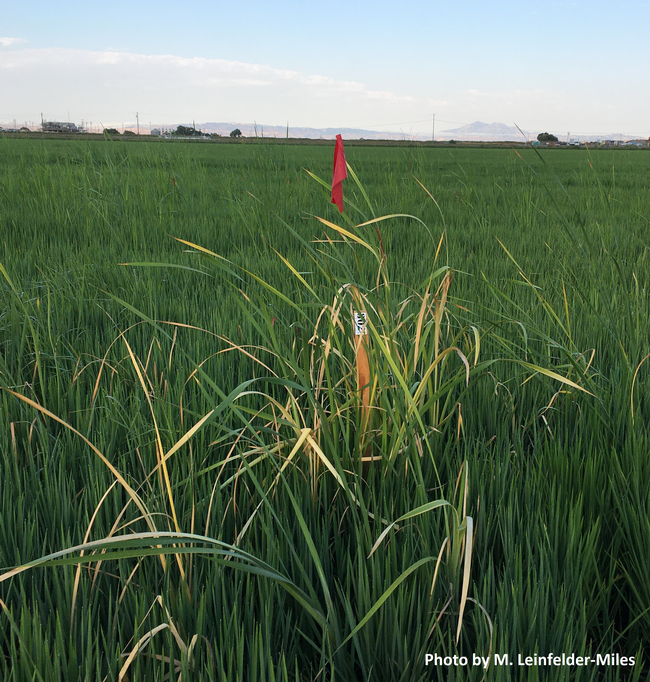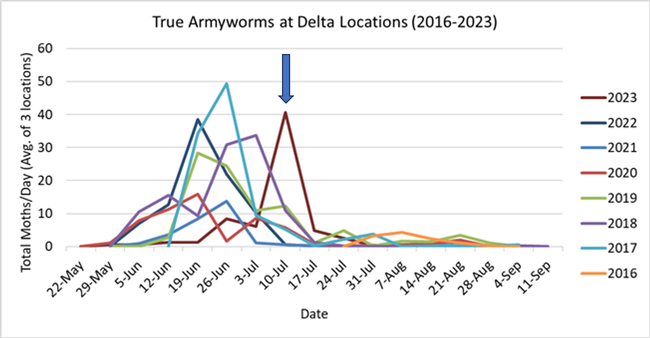Rice production in the Sacramento-San Joaquin Delta region has been steadily increasing in recent years. While Delta acreage is only a fraction of that in the Sacramento Valley, Delta yields are consistent with statewide averages. I estimate that in 2023, the Delta had around 10,000 acres of rice. In this seasonal recap, I'll overview UCCE research in Delta rice, as well as provide some observations about the 2023 season.

Armyworm Monitoring: I have been monitoring armyworm populations in the Delta since 2016, in collaboration with my UCCE colleague, Luis Espino. Monitoring involves scouting for damage and deployment of pheromone bucket traps that catch the moths. We can use trap counts and Growing Degree Day modelling (i.e. a temperature measure of time) to determine whether and when to treat fields. In 2023, we were thinking we might get away with minimal pressure because the population stayed low through early July. Then, the population spiked in mid-July, later than we had ever observed (Fig. 2). We surmise this was due to the cool, wet spring and later planting season. This year, Methoxyfenozide (Intrepid 2F) was available for use under full registration.
Disease Observations: We have identified diseases like stem rot, aggregate sheath spot, and rice blast on some Delta farms. It is important to scout for these diseases at late-tillering and early-heading because treatment timing is critical for management. Fungicide treatments are most effective when applied between late-boot and early-heading. Rice blast may be exacerbated by too much nitrogen, and stem rot and aggregate sheath spot by low potassium (K). K can be limiting in some Delta soils, especially where the straw is baled. There is a loss of approximately 28 lb K/ac for every ton of straw removed. Consider leaf tissue sampling for K between tillering and panicle initiation. The Y-leaf should have a K concentration of at least 1.5%. At heading, the flag leaf should have a K concentration of at least 1.2%. On-farm consultations are a service provided by UCCE. Please reach out if I can help identify pests and provide management guidelines.
Weedy Rice: We should continue to keep weedy rice on our radars because we have observed it in the Delta. In-season management includes rogueing or spot spraying before viable seed is produced. The organic herbicide Suppress is registered for spot spraying. Post-harvest management should include straw chopping, but not incorporation, and winter flooding. This will keep seed on the soil surface, where it can potentially deteriorate over the winter.
Variety Trial: UCCE collaborates with the California Rice Experiment Station to evaluate commercial varieties and advanced breeding lines. The San Joaquin County Delta location was one of ten locations in the 2023 statewide trial. The Delta is a test site for very-early maturing varieties because it has cooler growing conditions than other rice growing regions of the state. Variety trial results will be made available in the February 2024 newsletter.
Cover Cropping: With funding from the CDFA Healthy Soils Program and CA Rice Research Board, I am collaborating with Sara Rosenburg (UC Davis graduate student) and Whitney Brim-DeForest (UCCE rice advisor) to evaluate winter cover crops. We are interested to learn whether cover cropping improves soil carbon and nitrogen dynamics in the rice system. Since rice may be grown over multiple seasons without rotation, cover crops may provide an opportunity to introduce plant diversity, including nitrogen-fixing legumes. Trials will occur from 2022-2025, and the Delta site is one of three (also in Butte and Colusa counties). The 2022-2023 winter season presented several challenges for cover cropping. At the Delta location, seasonal rainfall exceeded 25 inches, and in the ten days after planting, the site received nearly 3.5 inches of rain. In addition to saturated soils, bird predation was severe. This fall, our aim is to plant earlier, if conditions allow.
Thank you to all the growers who collaborated with us on these projects. I wish everyone a good end to the year and a great 2024.
